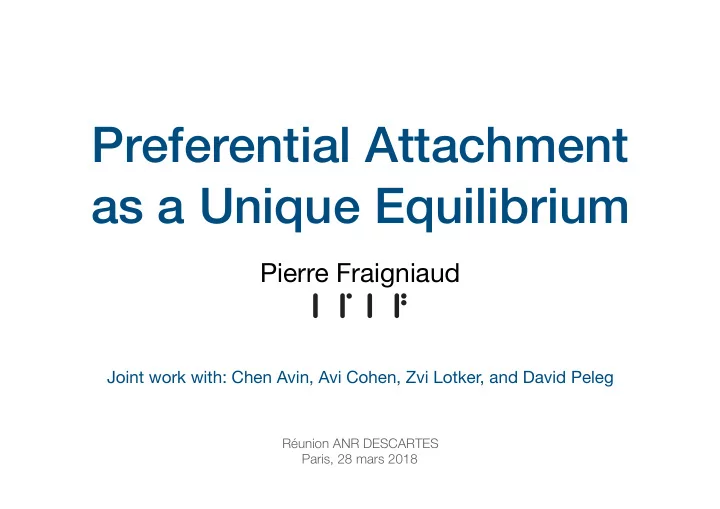

Preferential Attachment as a Unique Equilibrium Pierre Fraigniaud Joint work with: Chen Avin, Avi Cohen, Zvi Lotker, and David Peleg Réunion ANR DESCARTES Paris, 28 mars 2018
Common Knowledge A. Baronchelli, R. Ferrer-i-Cancho, R. Pastor-Satorras, N. Chater, M. Christiansen
Social Network Model Preferential Attachement (Barabási–Albert) • Nodes arrive one after the other • A new node u connects to k ≥ 1 existing nodes • Pr[u → v] ≈ deg G (v) • For k=1, PA yields a tree
Rationals for Preferential Attachement Empirical • Rich get richer aphorism (a.k.a. Matthew e ff ect) • Special case of Price's model Analytical • Generate graphs “similar to’’ real networks • Has desirable properties (degree sequence, short paths, clustering, etc.)
Why Social Networks are PA Graphs? • The what: PA • The how: Random graph theory • The why: Game theory A Hint why Social Networks are PA Graphs PA is the unique Nash equilibrium of a natural network formation game
The Network Formation Game: Framework • Society = graph • Social capital of a node = degree • Wealth of society = 𝝱 ∈ [0,1] • Formation process = new connections are: accepted with prob 𝝱 rejected with prob 1- 𝝱 , and pushed to a neighbor chosen u.a.r.
The Network Formation Game: Strategy & Utility • Nodes arrive one after the other • A new node u arriving at time t connects to one of the existing nodes • Pr[u → v] = π u (v) where π u is distributed over degree sequences — this is the strategy of node u. • Connections accepted according to probabilities ( 𝝱 t ) t ≥ 1 • Utility (v) at time t = 𝔽 [deg(v) at time t]
Example Step 4: 4 4 Step 5:
Universal Nash Equilibrium Remark There is a game for each stopping times τ≥ 1 and each wealth sequences ( 𝝱 t ) t ≥ 1 Definition A strategy profile ( π t ) t ≥ 1 is a universal NE if it is a NE for all stopping times τ≥ 1, and all wealth sequences ( 𝝱 t ) t ≥ 1
Universal NE Exist Definition π PA (v) = deg(v) / Σ z deg(z) = deg(v) / 2m Theorem PA is a universal NE Lemma Pr[u connect to v | T] = π PA (v) Proof: Pr[u connect to v | T] = 𝝱 π (v) + Σ w ∈ N(v) π (w)(1- 𝝱 )/deg(w) = 𝝱 deg(v) / Σ z deg(z) + Σ w ∈ N(v) ( (1- 𝝱 ) / Σ z deg(z) ) = deg(v) / Σ z deg(z) = π PA (v) ⧠
PA is a universal NE (proof) Assume PA is used. Assume that there exists a sequence ( 𝝱 t ) t ≥ 1 and some player v t for t ≥ 4 who could increase her utility by deviating from PA to π ’ t ≠ PA. X s = degree of player v t at time s ≥ t. X t = 1, and, for s>t, by the lemma, independently from π ’ t : X s = X s-1 + 1with probability X s-1 /2(s-2) X s = X s-1 with probability 1 - X s-1 /2(s-2) ⧠
Main Result Theorem PA is the unique universal NE Lemma Let Π =( π t ) t ≥ 1 be a strategy profile that is not PA. There exists a wealth sequence ( 𝝱 t ) t ≥ 1 such that Π is not a NE for ( 𝝱 t ) t ≥ 1 . Remark The result holds for only two di ff erent values 𝝱 t ≠ 𝝱 t’ .
Time-Invariant Games • The wealth remains constant over time • Definition 𝝱 t = 𝝱 ∈ [0,1] for every t ≥ 1. • Theorem If a strategy profile Π =( π t ) t ≥ 1 is a universal Nash equilibrium for the time-invariant game, then each player plays PA on every graph that is not a star (and if player t plays PA on the star S t − 1 then all subsequent players t’>t play PA on all graphs).
Degree-Consistent Strategies Definition : • A strategy π t is degree-k consistent if, for every degree-k node, the probability of selecting that node is independent of the degree sequence. • A strategy π t is degree consistent if it is degree-k consistent for every k ≥ 0. • A strategy profile Π = ( π t ) t ≥ 1 is degree consistent if π t is degree consistent for every t ≥ 1. Remark : PA is a degree consistent strategy.
Static Games • Systematically connect to the host • Definition 𝝱 t = 1 for every t ≥ 1. Theorem Let Π =( π t ) t ≥ 1 be a universal Nash equilibrium for the static game. If the strategy π t’ is degree consistent for every t’ ∈ {1,2,...,t − 1}, and π t’ (k)>0 for every k ∈ {1,...,t − 1}, then π t is a degree consistent strategy. In particular, if every player t’ ∈ {1, 2, ..., t − 1} played PA, then π t is a degree consistent strategy.
Conclusion • What if the recommendation proceeds recursively? (By same arguments PA remains a universal Nash equilibrium in this case too). • What if each new node connects to m > 1 existing nodes? • In addition to node-events, considering edge-events • What if the players have more knowledge about the actual structure than just its degree sequence? Thank you!
Recommend
More recommend